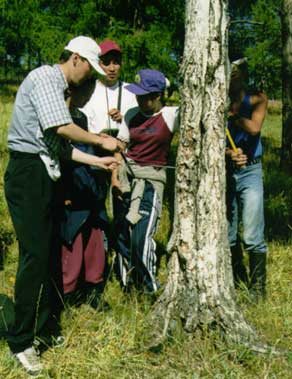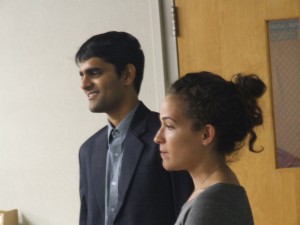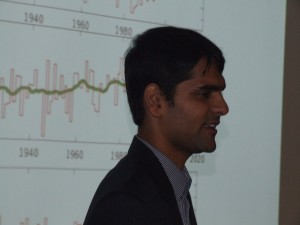“Trees, Climate, and Societal Relevance: A Case Study in Mongolia”
Guest Scientists: Caroline Leland and Mukund Palat Rao
Originally presented 20 Sep 2014 
Abstract:
Tree rings are a valuable proxy used for understanding past environmental conditions. Information attained from tree rings can provide information relevant to climatology, ecology, archaeology, and can also be applied to other important disciplines like infrastructure risk planning and index insurance. During our Earth2Class Workshop, we will discuss the fundamentals of tree-ring science (or dendrochronology), from collecting samples in the field, to processing tree-ring data, to using the data for answering important climate research questions. We will review studies which show how tree-ring data have been instrumental for evaluating past climatic variability in semi-arid Mongolia, which is highly sensitive to changes in moisture, over centuries and millennia. These findings have significant implications for the development of human societies.
We will also discuss the mechanisms behind severe climatic events (“dzuds”), which are severely detrimental to Mongolian livelihoods. Dzud events, which are anomalously harsh winters, also often preceded by summer drought, are particularly deleterious to livestock. Rearing of livestock, particularly for cashmere wool, is the traditional occupation of most Mongolians, and is the backbone of the economy. In the past decade Mongolia has seen multiple episodes of mass livestock mortality. In one of our ongoing projects at the tree ring lab, discussed as part of the workshop, we will show how extreme climate causes livestock mortality, and how paleoclimate histories can inform us about the periodicity of these extreme climate events, and finally how this information can be used to be better prepared for extreme climate.
NGSS Connections: MS-ESS2-2, ESS2-5, ESS2-6, ESS3-2, ESS3-5; MS-LS2; HS-ESS2-2, ESS2-4, ESS2-6, ESS3-1; ESS3-3, ESS3-5; HS-LS2
{Much of the information presented in the slideshow presentations has not yet been published, so these will be posted when available.
You can learn about tree ring studies and Mongolia from slideshows in earlier E2C workshops linked below.}
The value of dendrochronology (the study of tree rings) for understanding climate change has been discussed by other LDEO Tree Ring Lab scientists in previous E2C Workshops. You can find out more by browsing:
Resources for this Workshop
Introductory slideshow:
Learning from Tree Rings 2014 (pdf)
Classroom Resources
Selected tree-ring activities for the classroom:
“Nicole Davi’s “Gulf of Alaska Dendrochronology” Activity”
“Notes for the Lamont Open House Forest Walk“
“LDEO Forest Scavenger Hunt”
“What is My Tree?” game
“Learning from Tree Rings” by Diana Helene Frank (E2C participant)
“The Ultimate Tree-Ring Web Pages“
“Dendrochronology for Educators“
“NOAA Paleoclimatology”
“NOVA: Building a Tree-Ring Timeline”
“NOVA Methusalah Tree activity”
“Tree-Ring Record of Wetland Changes”
Related interesting story involving LDEO dendrochronology research can be found at
“Climate and Conquest: How Did Genghis Khan Rise?”
“Climatic conditions in the late 17th-early 18th century revealed through the study of tree rings may have be critical to the tonal qualities of instruments created by Stradivarius and Amati in Cremona”
Other Resources for This Topic
By Mark Kinver Science and environment reporter, BBC News
The study offers a link between changes to the climate and the rise and fall of human societies
Continue reading the main story
Related stories
An extensive study of tree growth rings says there could be a link between the rise and fall of past civilisations and sudden shifts in Europe’s climate.
Oxford Tree-Ring Laboratory: http://dendrochronology.net/introduction.asp#
Integrating Educational Technologies
General suggestions: Integrating Educational Technologies into Your Classrooms
Your assignment:
1) What characteristics make Social Media, such as Twitter and Facebook, effective as a classroom teaching tool?
2) When should Social Media-based activities be used for full-class instruction, and when should they be used for small groups or individual projects?
3) Describe strategies to locate suitable Social Media resources for your classes.
and
4) Design a lesson plan that incorporates at least one Social Media-based activity.
E2C Follow-up:
You may send your model lesson and other responses to this “assignment” to michael@earth2class.org. If suitable, we will post your work in the E2C lesson plans and/or add them to this section of the Workshop website.












Leave a Reply
You must be logged in to post a comment.